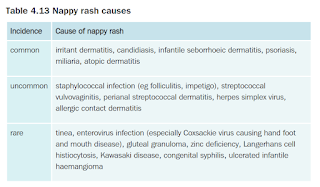Nappy Rash
Introduction
Nappy rash (also known as nappy dermatitis or diaper rash) is a nonspecific term used to describe inflammatory eruptions in the nappy.
- Nappy rash can range from mild erythema in the perianal region, to severe widespread erythema and ulceration.
Causes
Nappy rash can have many causes.
Irritant nappy rash is the most common cause of nappy rash. It is due to loss of the skin barrier function, from overdehydration, friction and exposure to faecal enzymes.
- Persistent cases often become colonised with Candida albicans.
NOTE: Infants usually develop psoriasiform nappy eruptions within the first 4 months of life. It presents as well-demarcated erythematous plaques. It can show scaling that resembles psoriasis, although this is uncommon. Involvement away from the nappy area is common and affects the limbs, face and scalp.
Indicative of Referral
Involvement of rash away from nappy area
- Suggests other causes such as psoriasis.
OTC treatment failure and severe rash
- Requires prescription-only treatments.
Pustules, erosions, ulcers or weeping in the nappy area
- May indicate a bacterial or viral infection.
Prevention of Nappy Rash
General measures to prevent and reduce recurrence of nappy rash include
- Use highly absorbent disposable nappies rather than cloth nappies, but if this is not possible, change cloth nappies every 2 hours and avoid plastic overpants or nappy liners.
- Change nappies as soon as they have been soiled.
- Leave the nappy off for as long as possible each day.
- Use a soap substitute and dispersible bath oil for bathing.
- Use a damp cloth and soap substitute for cleaning the nappy area (avoid baby wipes). If using wipes, fragrance-free and alcohol-free baby wipes are preferable.
- Apply a barrier preparation (e.g. zinc and castor oil cream, liquid paraffin 10% in zinc paste, dexpanthenol ointment, zinc oxide cream) after every nappy change.
Treatment of Irritant Nappy Rash
Low potency topical corticosteroid (e.g. hydrocortisone 1%) can be added for nappy rash not responding to simple treatment.
- If irritant is red and severe, replace hydrocortisone with a more potent topical corticosteroid for up to 7 days. Remember, the nappy area is prone to atrophy and striae.
Azole antifungals are effective against secondary infection with Candida.
- Miconazole or clotrimazole applied twice daily could be recommended if the rash has not improved within 5 days.
- If an antifungal cream is advised, treatment should be continued for 7 days after the symptoms have apparently cleared.


Comments
Post a Comment